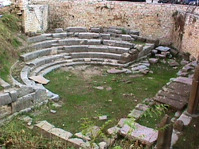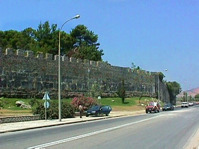Ancient Amvrakia
In 625 B.C the Korinthians came and stayed at Amvrakia, where there was the settlement of Dryopes. Its location was at the same place where there is today the city of Arta. Later, the Korinthians sent away the local habitants and constructed walls for Amvrakia. The town had a fortified port, Amvrakos, which was an exit to Amvrakikos bay.
For the history of the name of the town there are many different versions. The most probable one is that derives from the daughter’s name of the Dryopes’ king, Melaneas, whose name was Amvrakia. Amvrakia was the biggest town of Epirus, with a population of 100.000 habitants and took part in the battleship of Salamina against the Persians as well as in the battle of Plataies.
The strength of the town was shocked when it was defeated by the Akarnians and the Athenians at the battle of Olpes in Amfilochia, in 426 B.C.. In 338 B.C. it was conquered by the Macedonians, who in the end gave it in Pyrros, the king of Molossoi. In 295 B.C. Pyrros transfered here the capital of his state and decorated it with significant building (a royal palace, 2 theatres, temples, monument of Aineias, parliament, market, music school, statues of the 9 Muses, etc.).
In 187 B.C. is conquered by the Romans who later looted it (167 B.C.) and in 31 B.C. they transfered its habitants to their new established town of Nicopolis. After 1000 years, at the location of ancient Amvrakia, it was built the today’s city of Arta. Nowadays are saved at the old city of Arta parts of the castle and ruins of ancient Amvrakia.
It is also saved the ancient theatre of Amvrakia which is close to the church of St. Constantine, at the centre of ancient Amvrakia. It is about a small theatre built in 4th – 3rd century B.C. You can easily see the place of the orchestra and 4 rows of stands. The place of the orchestra is a perfect circle of a 6,70 metres diameter. During the succesive excavations were revealed a lot of findings that there are exhibited at the αarchaeological museums of Arta, Ioannina, Athens and London. The findings include jewels, ancient vessels, urns, coins, many kinds of tombs, fortification, etc.
During the excavations was also revealed the Holy Road of Amvrakia, inside the city of Arta, with a width of 12 metres. At this place it was also found a funerary stone with a rare archaic sign of the 6th century B.C. and the names of dead people, but also the name of Amvrakia, written in the Doric language.
The site of ancient Amvrakia is always open with free entrance.






